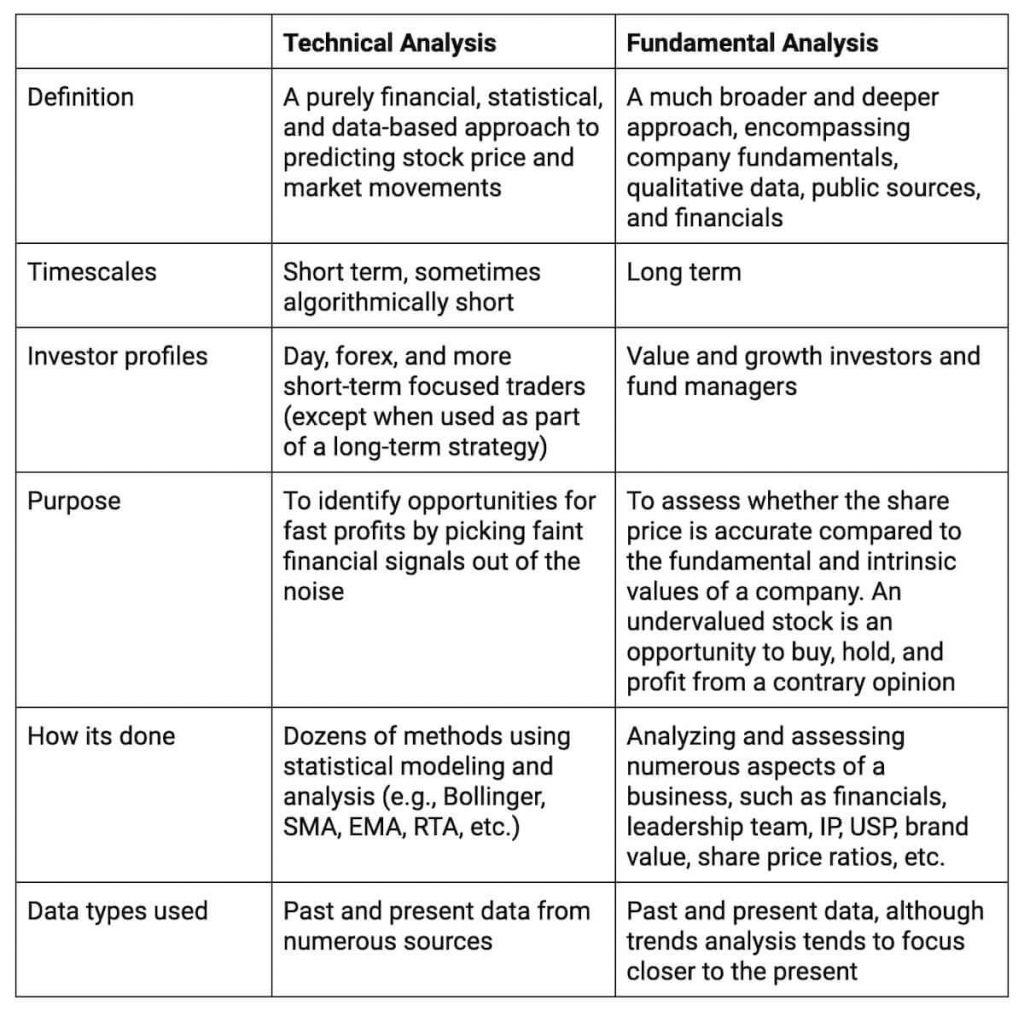
Maximizing returns and spotting opportunities that other investors miss is the name of the game with investing and/or short-term trading. Two of the most prominent schools of thought can help you decide what trades to make, but it’s up to you to determine which you want to rely on: technical analysis vs. fundamental analysis.
Technical analysis is mostly price- and volume-driven. The aim of technical analysis is to find statistical patterns in price movements and differentials to determine whether to buy, sell, or hold a security.
Fundamental analysis relies on a broader assessment of the potential value of stocks, shares, and other investment assets. With fundamental analysis, the idea is to make a value judgment as to whether the stock price reflects the “fair market price” and intrinsic value of the company.
Neither approach is right or wrong. Investors can use either of them or both. It comes down to personal preferences and the strategic approach an individual investor takes to long- and short-term investment decisions.
In this article, we’ll explain the pros and cons of technical analysis vs. fundamental analysis and the differences between them. We’ll also explore whether investors and analysts might want to use them separately or if investment strategies may be better served by combining them.
What Is Technical Analysis?

Technical analysis is a way of sifting for gold in a fast-flowing data stream. Every day, investors, analysts, day traders, and forex traders are overwhelmed with the noise of market and share price movements, fluctuations, ups and downs, and sudden reversals.
The idea behind technical analysis is to use technical indicators to cut through the noise to find meaningful signals that investors can profit from. Charles Dow, the co-founder of the Dow Jones Industrial Average and The Wall Street Journal, introduced the concept known as the Dow Theory.
The Dow Theory is the basis of technical analysis. Bull and bear signals are integral to that, as is the Efficient Market Hypothesis (EMH), which works on the assumptions that fundamental valuations are already baked into share prices.
The market has all of the information so investors need to focus on statistical data, and this can be used for short-term, fast-moving trades or for placing longer-term positions, such as being bullish or bearish against particular stocks and market predictions.
How Can You Implement Technical Analysis?
Technical analysts don’t worry about intrinsic value ⏤ they work on the assumption that share price statistical trends and the collective knowledge of the market have already hard-wired everything an investor needs to know about a company.
Statistical analysis is best performed using software and trading platforms and with access to the right data to weigh, assess, and evaluate numerous signals and technical indicators. Below is a non-exhaustive list of what you can assess when implementing technical analysis:
- Moving average: This is a basic but useful technical indicator that calculates the mean of a share price over a specific timescale, such as 30 days or 200 days. The simple moving average (SMA) and exponential moving average (EMA) are two of the most popular ways to calculate moving averages, with EMA putting more weight on the most recent data.
- Bollinger bands: Another technical analyst tool derived from moving averages, this uses standard deviations (one or two numbers above the SMA) to identify whether the market is either overbought or oversold quickly.
- Mean reversion: Share prices can move up and down wildly over hourly or daily timescales. But zoom out a little, and you’ll see that most revert to their mean. Bollinger bands and price-to-earnings ratio metrics are two of many ways to measure and monitor this statistical approach.
- Trading volume indicators: This is a way of seeing the volume of a security that has been bought and sold over a specific time period. Using the money flow index (MFI), you can see whether there’s much interest in a particular security, and it’s more useful than the relative strength index because it includes volume.
- Fibonacci numbers: Based on the work of a 12th-century Italian mathematical genius (the guy responsible for the numbers we use today!), Fibonacci ratios of 24%, 38%, 62%, and 76% help to identify retracement moments so investors can pick the best time to buy or sell.
- Average true range (ATR): This is one example of a popular volatility indicator that’s found solving equations based on share price highs, lows, and closing figures. The software can take care of this. Once you’ve got the data, you’ll have three “true ranges” to work with to assess price indicators and market volatility using the exponentially weighted average.
- Momentum indicators: A common one is the moving average convergence divergence (MACD) that subtracts the 26-period EMA from the 12-period EMA (“period” could be any timescale, such as hours or weeks, but days are the most common). When a share price goes over the MACD line, it’s a bullish signal, and when under, it’s bearish.
Let’s consider the pros and cons of technical analysis and relying on technical indicators to decide on a trading strategy.
Pros of Technical Analysis
- It helps make sense of the data: With so much data that investors can access, there has to be a clear, straightforward way to make sense of it. That’s the role of technical analysis. There are dozens of approaches and equations that investors and analysts can use, and numerous data sources and software tools to make this easier.
- Numbers don’t lie: The beauty of focusing on numbers is they don’t lie, especially when put under the microscope of technical analysis. Investor relations documents and public relations departments can lie, fudge the truth, and overplay what a business is doing (e.g., PR that shouts about “Huge new client wins, creating new jobs, making massive new investments!” could be hiding cash flow problems).
- Statistics can’t panic: One of the main reasons investors lose money is due to buying or selling too soon — panic. Fear of missing out fuels investor decisions, resulting in a herd mentality. Using statistical analysis and then applying the outcomes to simulators or leveraging algorithmic trading is one of the best ways to prevent guesswork, gut instinct, and panic from making a mess of an investment strategy.
Cons of Technical Analysis
- Overlooking the fundamentals: One of the cornerstones of fundamental analysis, EMH, is over 120 years old and assumes that share prices and the market know everything they need about the fundamentals behind a company. That’s rarely the case. Unless investors actually investigate the fundamentals themselves, how can you be sure you’ve got all of the information?
- Too reliant on software and statistics: Technical analysis takes the guesswork and gut instincts out of the equation. That’s a good thing in many ways. However, without considering the quantitative data, we risk basing investment decisions on logic alone, and humans aren’t always logical or rational (and therefore neither is the market).
- Overly dependent on data: The numbers, financial data, and calculations you put in have a direct impact on the statistical analysis that any software you’re using generates. Put poor-quality or inaccurate data in, and you risk building a trading strategy on false metrics and hope.
What Is Fundamental Analysis?

Fundamental analysis is popular with growth, value, and long-term investors because the theory says that it works over a longer time frame if implemented correctly.
Numerous investment heavyweights like Benjamin Graham (the pioneer of fundamental analysis), Warren Buffett (who learned this from Graham at Columbia University), and Charlie Munger use this approach for long-term investment decisions because it relies on business and economic fundamentals instead of short-term considerations such as micro price movements and the end-of-day share price.
The aim of fundamental analysis is to analyze as many indicators as possible to decide whether a business’s strengths and weaknesses are reflected in the “fair market value” of the share price. In other words, is an asset undervalued or overvalued by the market?
For example, let’s say that the market is currently pricing a company’s shares at around $200. That figure could be soft. Perhaps it’s a stock that has been flying under the radar, with the leadership quietly building a strong position in high-growth sectors. You apply fundamental analysis and think it’s actually worth $250. Buying now means you could make a profit. Or it could drop to $100, and you’ll lose money.
Identifying undervalued securities using fundamental analysis can give you a competitive edge on market trends. It’s a top-down research task that involves examining everything from company financial statements — e.g., profit and loss (P&L), cash flow, income, debt, and share price ratios — to the leadership team, intellectual property (IP), competitors, and the potential positive or negative impact of macro- and micro-economic indicators on a business.
How Can You Implement Fundamental Analysis?
Implementing fundamental analysis takes time. It usually falls to analysts who use a range of tools and market data sources to assess and evaluate everything from cash flow statements to economic factors, assets, liabilities, stock market charts, and a company’s return on equity.
Data sources for fundamental analysis include investor relations, announcements, and annual reports. The Securities & Exchange Commission EDGAR filings database is a valuable source for numerous U.S.-listed share price reports, such as 8-K, 10-Q, and 10-K.
Standardized fundamental data APIs from Tiingo can give you an advantage, especially when vast quantities of high-quality data are needed. Once you’ve got the data, then refer to the non-exhaustive list below of what you need to assess when making a fundamental analysis:
- Business model: Look at the core products, services, revenue cycles, customer lifetime value, and customer acquisition costs.
- Competitive advantages: Consider innovation, intellectual property/patents, customer loyalty, brand value, and the business’s unique selling point (USP).
- Market sector growth: See whether it’s growing or contracting and the split of domestic vs. overseas revenue or core sectors/markets vs. secondary.
- Leadership team: Evaluate the team’s track record, experience, performance, compensation, targets, and whether the C-Suite or board is buying or selling shares.
- Company’s financial statements: Look at the balance sheet, income statements, P&L, debt burden, and servicing costs, and whether the company is profitable based on earnings before interest and taxes.
- Share price financial ratios: There are numerous calculations you can make, e.g., earnings per share, price/earnings growth, price to book, and the price-to-earnings ratio.
- Economic impact: It’s worth reviewing everything that could impact a company, including the gross domestic product (GDP) of operating markets, interest rates, the Consumer Price Index, and the Purchasing Managers’ Index.
There are several other factors analysts can bring into the picture. However, this should serve as a useful starting point.
Now let’s examine some of the pros and cons of fundamental analysis as a method for assessing future price movements and price trends.
Pros of Fundamental Analysis
- More effective risk management: A combination of environmental, market/sector, competitor, and company financial analysis gives investors a clearer picture of intrinsic value. This ensures that portfolio risk and capital allocation can be revised more effectively, potentially improving long-term return on capital and reducing investment strategy downside risks, especially if there are signs of a bubble.
- Better for identifying opportunities: With so many signals and a hurricane of the market and financial data noise bombarding investors every day, it’s no wonder that too many make short-term bets that generate little or no returns. Fundamental analysis means taking your time to think long term and make smarter, more strategic investment decisions.
- Beat the market: Every investor and fund manager wants to beat the market and outperform the competition. Once you’ve noticed a share price or market-moving event, any advantage is gone, especially with algorithmic trading tools making automated trades in nanoseconds. The only way to potentially make smart strategic investments before announcements are made is to apply deep-dive, data, and quantitative-driven fundamental analysis to specific companies and sectors.
Cons of Fundamental Analysis
- The risk of missing something: Fundamental analysts need to assess vast amounts of data to make investment decisions and recommendations. You could miss or overlook a crucial piece of data, producing a false impression of a company’s fundamentals, financials, and other factors.
- Unknown dangers and pitfalls: Unless you’ve got an intimate knowledge of a particular company and its market, sector, and geoeconomic factors, how can you be sure that a share price is undervalued or overvalued? A startup competitor could destroy the value of a larger, more established company with an innovative new must-have product; e.g., Netflix coming along and wiping out Blockbuster.
- Harder to test qualitative theories: Unlike purely quantitative approaches such as technical analysis, technical indicators, backtesting stocks, and investment strategy simulations, qualitative analysis is harder to test. It’s more effective than gut instinct, but there are limitations that could impact the outcomes of investment strategies.
Fundamental Analysis vs. Technical Analysis: A Quick Reference Summary
To avoid confusion, we’ve made a table to show how these two approaches to maximizing investment opportunities and trades compare. Use this as a handy reference guide for technical analysis vs. fundamental analysis.

Make Smarter Investment Decisions With Technical Analysis and Fundamental Analysis
Despite the fact that technical analysis vs. fundamental analysis are two opposing schools of thought, you don’t need to limit trading strategies to one or the other. You can use both, especially for long-term investment and capital allocation plans.
For short-term trading, fundamental analysis is more useful, especially when combined with simulations and algorithmic trading. However, for trading positions that you expect to hold longer than a millisecond or a few days, a combination of fundamental and technical analysis could give you an advantage.
Of course, any investment strategy is only as strong as the data you feed into the calculations and analysis software.
Tiingo, an industry-leading source of data, has everything you need for fundamental and technical analysis, including end-of-day stock prices, news feeds, and other financial data pipelines.
Sign up for Tiingo’s reliable financial markets APIs to access the financial data you need for technical and fundamental analysis.
Leave a Reply